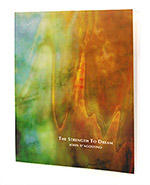|
|
 |
|
|
-
|
The Representation of Vision
|
|
-
|
|
|
|
|
| Detail: William Blake, Elohim Creating Adam, 1795. |
|
|
Poet, painter, engraver and prophet, William Blake (1727-1857) is arguably the greatest artist Britain ever produced, whose singular talents in both words and pictures were neglected for almost a century after his death. For Blake, a man’s vision was the one and only great fact about him. Poetry, art and religion were not separate activities, but all extensions of man’s greatest quality: his imagination. For an artist, the only question that interested Blake was: Do you see?
|
|
|
|
|
|
-
WORDS BY: John D’Agostino
WORKS: www.EmpireofGlass.com
-
|
|
|
The task Blake set out for himself was not to just depict a scene, but the representation of vision. For Blake, man’s ‘Original Sin’ was the losing of his visionary faculty to focus instead on more practical matters. The word mysticism originates from the ancient Greek, literally – to shut the eyes. In Blake, here is the artist-mystic, someone who claimed to have visions his whole life. ‘Seeing’ for Blake was not simply using the eyes, but the brain as well. Blake set out to use discipline and will-power on his senses to attempt to see further and deeper than any artist before him.
|
|
|
|
|
|
-
|
|
To see a world in a Grain of Sand,
And a Heaven in a Wild Flower,
Hold Infinity in the palm of your hand,
And eternity in an hour.
|
|
-
|
|
|
|
|
 William Blake, The Ancient of Days, 1794. |
|
|
In his prophetic books, Blake juxtaposed images and text in a way not done since the Middle Ages. His imagery is populated with great winged beasts, angels, demons, ethereal women, children at play, and imposing Yahwehs with long white beards. Blake synthesized many different myths and religious histories, both Christian and pagan, into psychodramas where the main action often would take place within the mind of a single individual. His creatures glow with a spectral, inner phosphorus, summoned up it would seem, directly from heaven or hell itself.
Rimbaud said: “The poet should be a visionary; one should make oneself a visionary . . .” This was Blake’s credo. Despite Blake’s unique gifts, he felt that the visionary faculty was something naturally occurring in all men. ‘The Man of Genius’ or those he called ‘The Men of Imagination’ were only individuals who had spent time and effort disciplining the visionary faculty.
Vision was not something you were born with, or somehow ‘caught’ by accident like the measles, but rather the result of a long, hard discipline of the senses, the forcing of the imagination in new directions. For Blake, everyone could see a world in a grain of sand – but only if they chose to see it. British author Colin Wilson deemed this essentially two different ways of seeing the world, that, can simply be called ‘The Inspired’ and ‘The Uninspired.’ The artist’s task is to connect the two. In Blake, imagination was “the real and eternal world”- of which the everyday “vegetable universe” was but just a faint shadow. Blake’s was not the reality of the retina. His pictures were a superior reality. Blake conceptualized the imagination – both in verse and image – as active, dynamic and most importantly, volitional. He makes almost all other artists seem like victims of impotent aspirations in comparison.
|
|
|
|

|
|
-

This text first appeared as part of the paper The Strength to Dream: How Remnants of the Past Illustrate a Legacy of the Representation of Vision by John D’Agostino, published in ArtForum’s Art&Education Papers Archive, 2010.
View the paper online here.
Purchase Hardcopy here.
-
|
|
|
As Blake puts it: ‘And I know that This World is a World of Imagination & Vision… to the Eyes of the Man of Imagination, Nature is Imagination itself. As a man is, so he sees.”
Thomas Harris’s Hannibal Lecter series of novels such as Red Dragon and The Silence of the Lambs often make use of Blakean imagery. In Michael Mann’s underrated thriller Manhunter (1986), William Peterson’s knack for seeing as killers do leads him to Francis Dollarhyde, the ‘Tooth Fairy’ killer. Kidnapping an unscrupulous tabloid reporter, Dollarhyde shows his bound victim slides of William Blake to terrify him. On the screen he shows him Blake’s The Great Red Dragon – the combined fears of all of mankind: the Prince of Darkness himself, from The Book of Revelations.
Do you see? Do you see? Dollarhyde asks. For Blake, the answer was definitely a yes. •
|
Tags: Art and Education, artist, Colin Wilson, Hannibal Lecter, imagination, inspiration, John D'Agostino, man of genius, men of imagination, Michael Mann, mysticism, seeing, The Outsider, The Strength to Dream, vision, visionary, William Blake
|